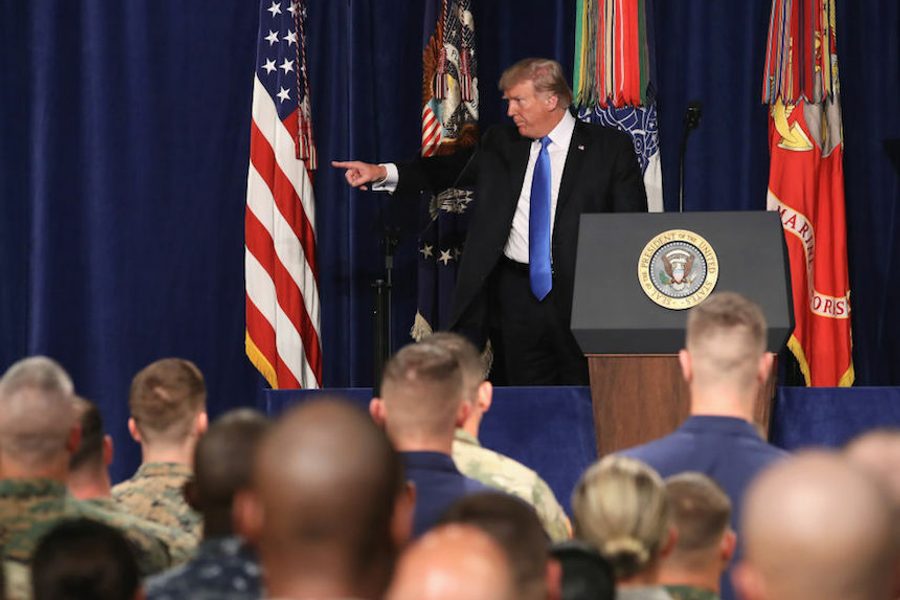With Afghanistan Surge, Donald Trump Just Took Ownership of the Forever War
Monday’s announcement shows Trump will continue the same failed strategies of his predecessor.
Seelai Popal

President Trump’s August 21 speech about his strategy for the war in Afghanistan sounded eerily familiar. First, standing before members of the military at Fort Myer in Virginia, he lauded the “vigilance” and “sacrifice” of the U.S. armed forces. Then, as if we needed a reminder, he quickly brought up the horrors of 9/11, and the breeding ground from which the terrorists came 16 years ago: Afghanistan. The format of his opening similar enough to President Obama’s 2009 address that, before Trump got any further, it was evident where his speech was headed: He was to continue, by sending more troops, to escalate the Afghanistan War.
In 2009, in a speech like Trump’s, Obama announced he would be sending an additional 30,000 troops in a final push to clear the region of terrorists, with the plan of a gradual pull-out beginning in 2011. We all know how that worked out: It didn’t. By 2015, Obama’s plan to fully pull all troops from Afghanistan by 2016 was cancelled. In his words, “the security situation is still very fragile.”
How, then, does Trump plan to eradicate terrorism with 4,000 additional troops and no defined timetable? And why is he trying to send more troops when very recent history suggests inevitable failure?
The cost and profits of prolonged war
The short answer: War is extremely profitable. Since 2001, almost $800 billion has been spent on the Afghan war so far. Arms manufacturing companies and defense contractors like Lockheed Martin and Raytheon benefit significantly when the United States is engaged in long-term, continuous warfare.
This may have helped lead Trump to contradict the bilateral security agreement signed between Afghanistan and the United States in 2014, which called for a reduction of U.S. forces to a military advisory presence at the U.S. embassy in Kabul by the end of 2017. Instead, Trump said that “conditions on the ground, not arbitrary timetables, will guide our strategy from now on. America’s enemies must never know our plans or believe they can wait us out. I will not say when we are going to attack, but attack we will.”
Trump had previously criticized the war in Afghanistan for being futile and inefficient. On Twitter, Trump posted about the war on several occasions in 2011, 2012 and 2013, calling it a “waste” and advocating a total withdrawal from the country. As candidate Trump, he told CNN’s “New Day” on Oct. 6, 2015 that he believed it was a mistake for the U.S. to enter Afghanistan. Only later that month, however, he claimed to have been calling the Iraq War a mistake, and said the U.S. had been right to invade Afghanistan. During a presidential debate in March 2016, he doubled down, saying, “I think you have to stay in Afghanistan for a while.” In short, he has shifted his stance and appears confused about the exact history of U.S. military involvement.
In his August 21 speech, he said, “My original instinct was to pull out [of Afghanistan], and historically I like following my instincts. But all my life, I have heard that decisions are much different when you sit behind the desk in the Oval Office.”
Trump now calls for “an honorable and enduring outcome,” but this cannot be achieved by killing innocent Afghans across the provinces. Since Trump took office, the U.S. military has dropped almost 2,000 air strikes in Afghanistan, causing an untold number of civilian casualties. And in April of this year, the military dropped the 22,000-pound Massive Ordnance Air Blast (MOAB) bomb in the Achin district of Nangarhar province. The MOAB is the largest non-nuclear bomb used in history. More troops will likely mean even more deaths and continued air strikes.
In addition, Trump’s argument that “a hasty withdrawal would create a vacuum [that] terrorists … would instantly fill” is a red herring. After 16 years of U.S. occupation, the Taliban are stronger than before and show no sign of stopping their reign of destruction and instability. Speaking to The Intercept, one Taliban-allied commander, Esmatullah Bashari, explained how the U.S. presence was actually helping the group:
“After every strike, people, sometimes the whole clan, join our fight,” said Bashari, with characteristic exaggeration. “Especially when women and children get killed, the anger is enormous, they don’t have any other choice than to fight.”
If the U.S. continues with a kill-first, peace-later attitude toward the war, we will only see more casualties and perpetual bloodshed. The “fog of war” will become a storm we cannot clear.
A new anti-war Left?
During the Obama administration, the anti-war movement was largely absent. Even groups that were vocal against the Iraq War were noticeably silent when it came to Afghanistan. However, now that Trump, abhorred by the Left, has come out in support for the war in Afghanistan, one silver lining is that perhaps people will start to organize against the war in the same manner they have against racism and Nazism.
As has been made clear, Americans cannot “save” the Afghan people; only Afghans can save themselves. The most important step that we Americans can take to end this war and stop the bloodshed is to support the sovereignty of Afghans and their right to self-determination. We can start by supporting the work of groups and individuals working to genuinely help Afghanistan, such as Razia’s Ray of Hope Foundation, which works to educate women and children, and Emran Feroz, a journalist who commemorates civilian drone victims. We must call on the popular resentment and dislike of Trump and turn the tide against a war that has cost hundreds of thousands of innocent lives, severely damaged the country’s infrastructure, and caused irreversible harm to the environment and natural resources.




